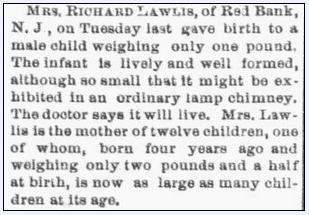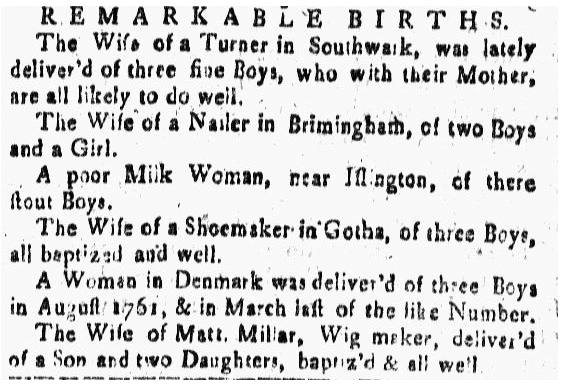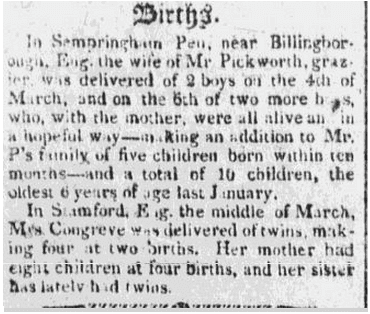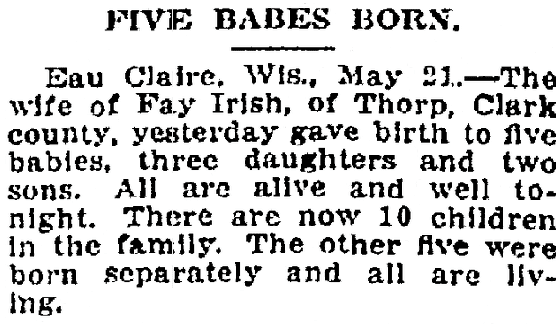Introduction: In this article, Mary Harrell-Sesniak searches old newspapers to find stories about multiple births—and adds a personal touch by discussing her own twins. Mary is a genealogist, author and editor with a strong technology background.
I recently wrote about querying historical newspaper articles for baby and birth records, but focused on singleton research (see: Genealogy Tips for Baby Research). Within GenealogyBank’s Historical Newspaper Archives, you’ll find numerous extraordinary reports of multiple births and large families, some of which I’d love to share.
History of Family Size and Fertility
Statistics show increased birth rates for today’s mothers, but don’t seem to factor in the large families of yesteryear.
During the 18th Century, the average family size was probably between 10-11 children, a statistic that dropped to 3.19 by 1987. (See New York Times Archives of 2 June 1988: “Size of U.S. Family Continues to Drop, Census Bureau Says.”)
Without birth control, women who continued to get pregnant remained fertile well into their 40s, resulting in many mouths to feed. At her death in 1769, Mrs. Ruth Skinner of Portsmouth, New Hampshire, had a family of 196, including 13 of her own children and their resulting progeny.

Premature Births
Contrary to popular opinion, premature babies did survive in earlier times, but until I researched the issue I didn’t realize how many babies survived before the invention of the infant incubator.
For example, this 1884 newspaper article reported that the Richard Lawlis family of Red Bank, New Jersey, had a family of 12 children. One extraordinary premie, born four years earlier, survived after only weighing 2½ pounds at birth, and another just-born premie was a diminutive 1-pounder, who was so small the child could be “exhibited in an ordinary lamp chimney.”

Twins and Triplets
Twins and triplets were greeted with as much enthusiasm in early days as they are today. This contradicts the notion that multiple births are a modern-day invention caused by fertility drugs.
In 1767, there was a report of the remarkable births of six sets of triplets born in England, Germany and Denmark. The woman in Denmark had also given birth to triplets previously, in 1761!

In 1879 a mother-daughter combination from a Massachusetts family was blessed with five children born within one hour, in the same house. The mother had triplets and her daughter, twins. As some might joke, what do you suppose was in the water in that neighborhood?

As technology improved, newspapers printed photos of twins and triplets, and often ran stories following what happened to multiples throughout their childhood. Weren’t Helen, Dewey and Ida McKinley darling in their matching outfits! Do you notice anything special about Dewey? He was one of the many boys at that time whose mothers dressed him as a little girl when young.

“Children Ride Free” Discounts
We always greet discounts for children as a blessing, but as this 1846 article reported, the “free child” bonus could get out of hand. Children could ride free on some stagecoaches in those days, but if a mother of three sets of twins bought tickets, along with other mothers averaging three children each, the driver would only make pennies. As the writer reported:
On some occasions I have known an omnibus to be so swarmed with the infantile race that the top layer of them would touch the roof, and even then the driver would stop at every corner to take in more.

Quadruplets
While reports of twins and triplets can be found in historical newspapers, sometimes one even finds accounts of quadruplets.
The Cantwell quads were born in Delaware in 1893. The four boys, whose weights ranged from four pounds to five pounds nine ounces, were reported to be “well formed and in perfect health.”

Although rare, it is possible for multiples to be born on separate days. The condition may be indicative of a mother with multiple wombs. Mrs. Pickworth of England delivered two boys on the 4th of March 1814 and an additional two on the 6th. Unfortunately, later reports indicated that they did not survive.

Quintuplets
The odds of having quintuplets are about 1 in 60,000,000, and when these special arrivals are born, they are reported across the country. One of the more famous sets was the Dionne quints, who—as this article reports—were featured in movies.

A lesser-known set was the Irish quints, born in 1909 in Wisconsin.

My Twin Family Story
My husband and I are the parents of fraternal twins, but their birth was something of a miracle. These two darlings were born without fertility drugs and after being told we might not become parents.

Our twins were a surprise from a genealogical standpoint as well. I remember their genealogist grandmother reporting she had never located any direct ancestors who were twins. On my father’s side there were twins five and seven generations before them, which dispels the myth about skipping a generation!
Fun Facts about Twins
- The older you are, the more likely you are to have fraternal twins. This is due to differences in a follicle stimulating hormone (FSH) that affects ovulation.
- If there are twins in the family, you’re more likely to have twins.
- If you’ve given birth to fraternal twins, you’re twice as likely to do it again.
- The more pregnancies you have, the greater the chance of having twins.
- Body type affects the likelihood of having twins. The smaller you are, the less likely you are to have multiple births.
- Twins are more common for African Americans than Caucasians, and less common for Hispanics and Asians.
Hilarious Questions That Parents of Multiples Encounter
Mothers of multiples (including myself) report having heard silly questions from strangers admiring their children. These are some of my favorites.
- Are they related? (Of course!)
- Are they real twins? (Of course!)
- Are they paternal twins? (Did you mean fraternal twins?)
- Did you plan to have twins? (Wouldn’t it be wonderful if someone could plan this!)
- Can they read each other’s minds? (Can anyone read someone’s mind?)
- When one cries, does it wake the other one? (Yes!)
- What do you do when they cry at the same time? (It was never easy. You do what you can to comfort two at once.)
- Which one is the evil twin? (Seriously, no child is evil. All children are blessings!)
- The most hilarious and often-presented comment we ever heard about our fraternal girl and boy twins was: “Are they identical?” I usually chuckled with this response: “No of course not! If one is a boy and one is a girl, there has to be something different!”
- The second-funniest comment occurred when my daughter was dressed in pink and my son in blue: “Which one is the girl and which one is the boy?”
- My son always had a wonderful answer to “Which one of you was born first?” He would reply: “She was, but only because I kicked her out.”
Articles on Multiple Births
- Funny comments made to parents of twins: https://www.facebook.com/notes/twiniversity/stupid-things-people-say-to-parents-of-twins/208746975832820
- Twin Tips from twinsuk.co.uk (describes types of twins): http://www.twinsuk.co.uk/twinstips/4/140/twin-pregnancy—multiple-births/types-of-twins–identical-fraternal–unusual-twinning/
- Wikipedia’s Lists:
- Twins: http://en.wikipedia.org/wiki/List_of_twins
- Triplets: http://en.wikipedia.org/wiki/List_of_triplets
- List of Multiple Births: http://en.wikipedia.org/wiki/List_of_multiple_births
Do you have twins, triplets or quadruplets in your family tree? Share with us in the comments.
Related Articles about Babies:
- Popular Baby Names from the Early 1900s to Today
- Genealogy Tips for Baby Research
- Birth Announcements – newspapers are packed with them

My great great grandfather, Jens Christian Jensen, born 23 Apr 1847 in Transmark, Bindslev Parish, Hjorring, Denmark, had 21 children with two wives. Seven born between 1870 and 1882 in Livingston Co., IL with his first wife Kirsten Marie Jakobsen, and 14 born in Dawson Co., NE with his second wife, between 1883 and 1903 which included 2 sets of fraternal twins. All 21 children lived to adulthood.
Dawn,
Thank you for sharing your family story. That is amazing that all the children survived!
Mary
Jens Christian Jensen’s second wife was Marie Jensen.
Dawn,
Thank you for this update.
Mary
Cope triplets – Roxbury , Mass
October 30, 1982 (3 boys)
Beth Isreal Hospital/Brigham & Women Hospital, Boston, Mass
Mother – Cherie Cope, Twin
Sister -Jennifer Terry, Twin ( mother to a set of twins – boy & girl)
Cherie,
Thank you for sharing this delightful comment about two generations of twins in your family.
Mary